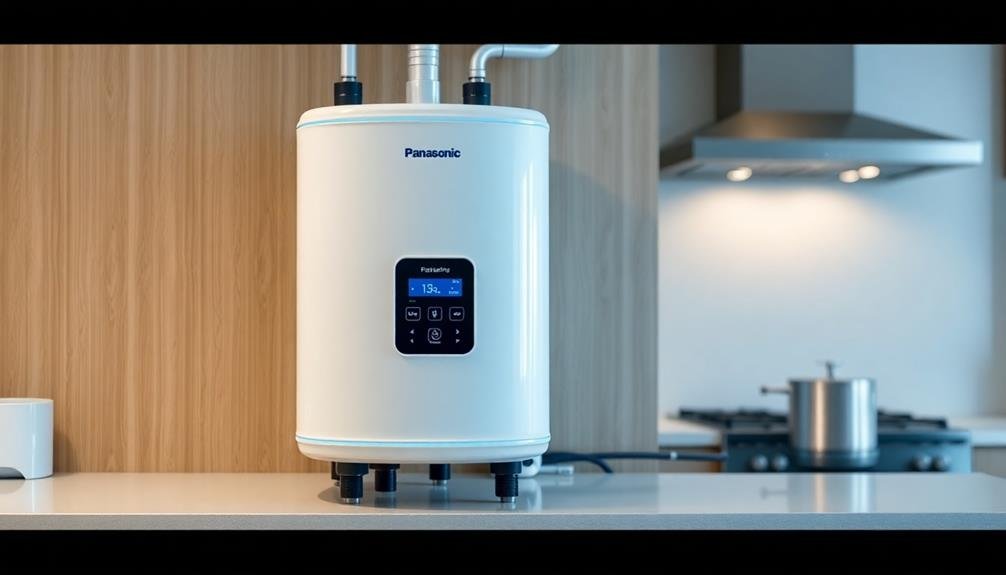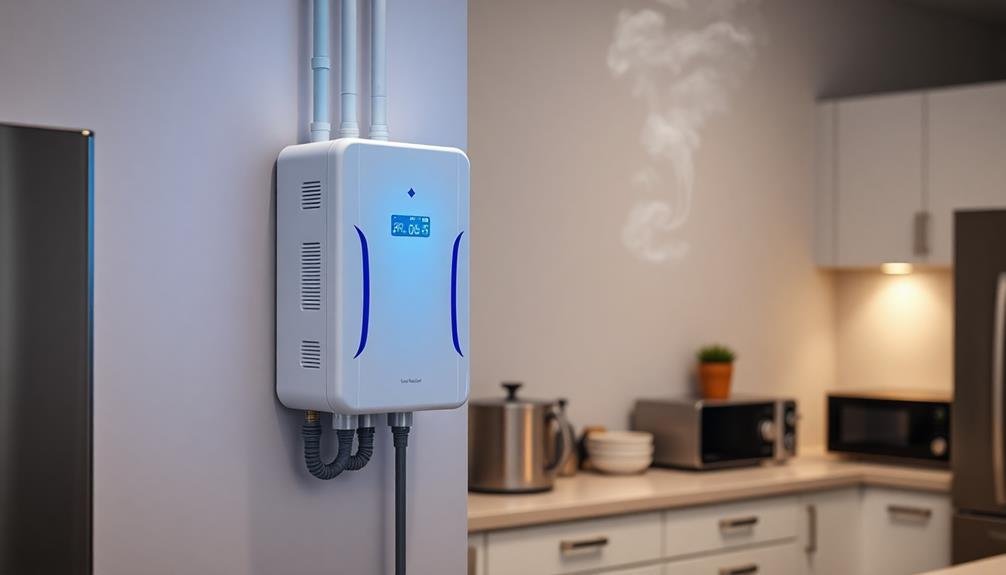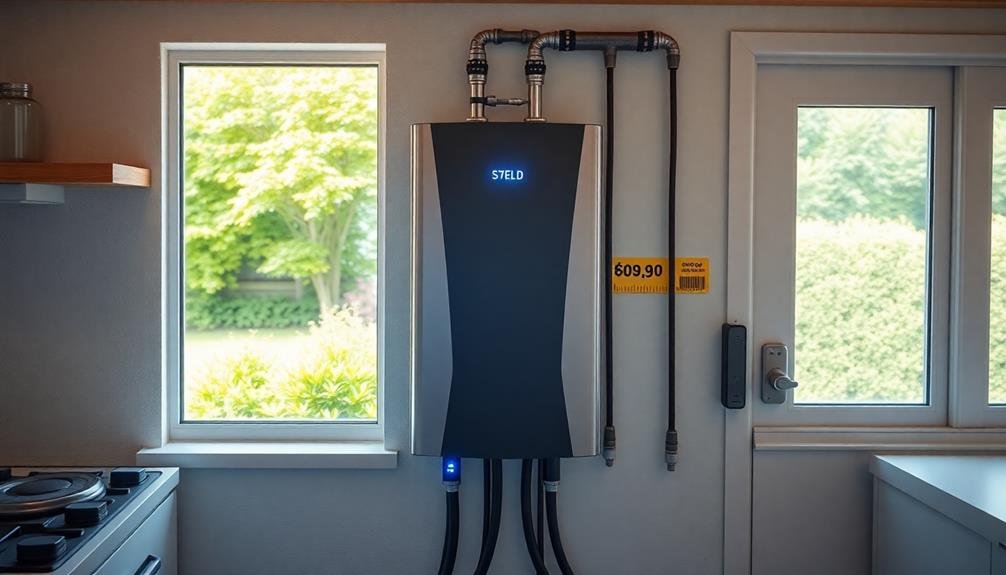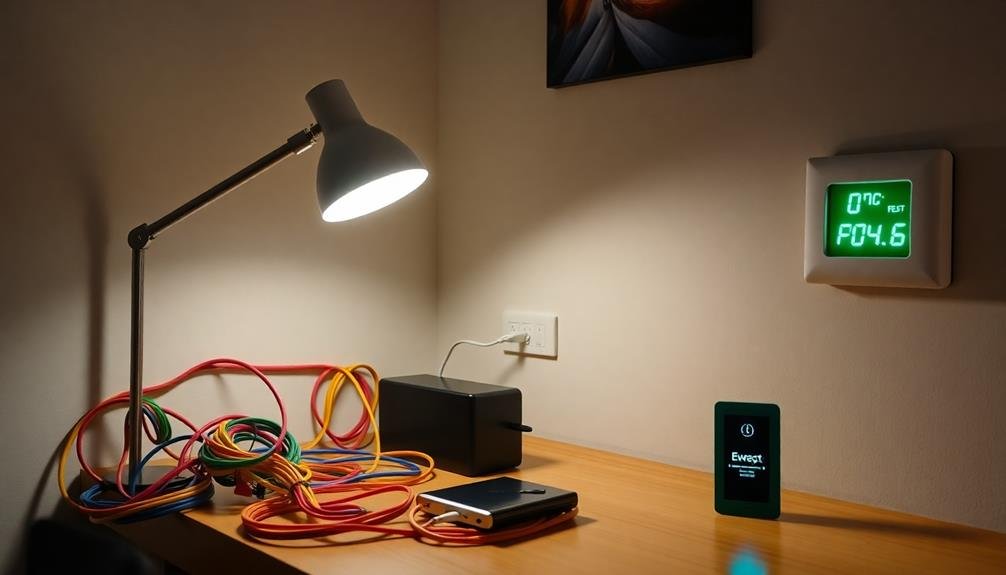Looking for affordable home fuel cell systems? You've got options. The Panasonic ENE-FARM and BlueGEN Ceramic Fuel Cell offer high efficiency and low emissions. Viessmann's Vitovalor PT2 combines a fuel cell with a gas boiler for extensive energy needs. SOFCMAN and Aisin COREMO units provide compact, quiet operation. Toshiba's H2Rex generates both electricity and hot water, while the Elcore 2400 Micro-CHP system boasts impressive overall efficiency. These systems use natural gas or propane, eliminating the need for hydrogen storage. They're designed for easy integration and minimal maintenance. Exploring these innovative solutions could transform your home's energy landscape.
Panasonic ENE-FARM Fuel Cell System

Frequently praised for its efficiency, the Panasonic ENE-FARM fuel cell system offers homeowners a budget-friendly solution for generating electricity and heat. This innovative system uses natural gas or propane to produce hydrogen, which then powers the fuel cell to create electricity. The excess heat generated during this process is captured and used for hot water and home heating, maximizing overall energy efficiency.
You'll find that the ENE-FARM system can reduce your home's CO2 emissions by up to 50% compared to conventional power sources. It's designed to operate quietly and continuously, providing a reliable source of power even during grid outages.
The system's compact size makes it suitable for various home layouts, and its user-friendly interface allows for easy monitoring and control of your energy consumption.
While the initial investment may seem substantial, the long-term savings on your energy bills can offset the cost. Panasonic offers different models to suit various household sizes and energy needs, ensuring you can find a system that fits your budget and requirements.
With proper maintenance, the ENE-FARM can last for years, making it a cost-effective choice for environmentally conscious homeowners.
BlueGEN Ceramic Fuel Cell
You'll find the BlueGEN Ceramic Fuel Cell offers impressive efficiency and power output for your home energy needs.
This system can generate up to 13,000 kWh of electricity annually, potentially covering a significant portion of your household's power consumption.
Installation and maintenance are straightforward, with the unit requiring minimal space and annual service checks to guarantee peak performance.
Efficiency and Power Output
The BlueGEN Ceramic Fuel Cell stands out with its impressive efficiency and power output. You'll be pleased to know that this system boasts an electrical efficiency of up to 60%, which is considerably higher than many other fuel cell technologies. It can generate up to 1.5 kW of continuous power, enough to meet the electricity needs of an average household.
What sets the BlueGEN apart is its ability to operate continuously, providing a steady and reliable power source. You'll benefit from:
- Lower energy bills due to its high efficiency
- Reduced carbon footprint with cleaner energy production
- Potential to sell excess electricity back to the grid
The system's power output remains consistent throughout its lifespan, ensuring you'll have a dependable energy source for years to come.
It's designed to work alongside your existing power supply, seamlessly integrating into your home's electrical system. You can monitor and control the BlueGEN's performance through a user-friendly interface, allowing you to optimize its output based on your energy consumption patterns.
This level of control helps you maximize the system's efficiency and minimize your overall energy costs.
Installation and Maintenance
When it comes to installation, the BlueGEN Ceramic Fuel Cell system offers a relatively straightforward process. You'll need to connect it to your home's natural gas supply and electrical system. It's recommended to hire a certified technician for the installation to guarantee safety and compliance with local regulations.
The unit is compact, measuring about the size of a dishwasher, so it won't take up much space in your utility room or basement.
Maintenance for the BlueGEN system is minimal, which is great news for your budget. You'll need to replace the fuel cell stack every five to seven years, depending on usage. This is the most significant maintenance cost you'll encounter.
Regular check-ups by a qualified technician are advised to keep the system running efficiently. You should also clean or replace the air filter annually.
The system's built-in monitoring technology allows for remote diagnostics, reducing the need for on-site inspections. This feature helps identify potential issues early, saving you money on repairs.
Viessmann Vitovalor PT2 System

Stepping into the world of affordable fuel cell systems, Viessmann's Vitovalor PT2 stands out as a promising option for homeowners. This compact unit combines a fuel cell with a gas condensing boiler, offering an efficient solution for both heating and electricity needs.
You'll appreciate its ability to produce up to 750 watts of electrical power and 20 kW of thermal output, making it suitable for most residential applications.
The Vitovalor PT2 boasts several key features that set it apart:
- High overall efficiency of up to 90%
- Integrated energy management system for optimized performance
- User-friendly interface with remote monitoring capabilities
You'll find that installation is straightforward, with the system designed to fit seamlessly into your home's existing infrastructure.
Its modular design allows for easy maintenance and future upgrades. While the initial cost may be higher than traditional heating systems, you'll benefit from significant energy savings over time.
The Vitovalor PT2's ability to generate electricity on-site reduces your reliance on the grid, potentially lowering your utility bills.
With its reliable performance and eco-friendly operation, this system offers a compelling choice for budget-conscious homeowners looking to embrace fuel cell technology.
SOFCMAN Energy Residential Unit
As we explore more budget-friendly options in the home fuel cell market, SOFCMAN Energy's residential unit emerges as a notable contender. This Chinese-made system offers an affordable entry point for homeowners looking to embrace fuel cell technology without breaking the bank.
You'll find that the SOFCMAN unit utilizes solid oxide fuel cell (SOFC) technology, known for its high efficiency and fuel flexibility. It can run on natural gas or propane, making it adaptable to various home setups. The system generates both electricity and heat, allowing you to power your home and warm your living spaces simultaneously.
One of the key advantages of the SOFCMAN unit is its compact design. You won't need to dedicate much space to house this system, making it ideal for smaller homes or apartments. The unit's quiet operation guarantees it won't disrupt your daily life.
While it may not boast the same output as some higher-end models, the SOFCMAN residential unit offers a good balance of performance and affordability.
You'll appreciate its user-friendly interface and minimal maintenance requirements, making it an accessible option for those new to fuel cell technology.
Aisin COREMO Fuel Cell

Another compelling option in the budget-friendly home fuel cell market is the Aisin COREMO Fuel Cell. This innovative system, developed by the Japanese automotive parts manufacturer Aisin Seiki, offers an efficient and cost-effective solution for residential power generation. The COREMO unit utilizes solid oxide fuel cell (SOFC) technology, known for its high electrical efficiency and durability.
You'll find that the Aisin COREMO Fuel Cell stands out for several reasons:
- It boasts a compact design, making it suitable for various home sizes.
- The system operates quietly, ensuring minimal disruption to your daily life.
- It can be easily integrated with existing home energy systems.
The COREMO fuel cell generates electricity through an electrochemical reaction between natural gas and oxygen, producing heat as a byproduct. This heat can be used for space heating and hot water production, maximizing the system's overall efficiency.
You'll appreciate the unit's ability to provide a stable power supply, even during grid outages, enhancing your home's energy security.
While the initial investment may be higher than traditional power solutions, you'll find that the long-term savings on energy bills and reduced carbon footprint make the Aisin COREMO Fuel Cell a worthwhile consideration for your home's energy needs.
Toshiba H2Rex Residential Model
While the Aisin COREMO Fuel Cell offers impressive features, Toshiba's H2Rex Residential Model presents another compelling option in the budget-friendly home fuel cell market. This system utilizes solid oxide fuel cell (SOFC) technology, which operates at high temperatures for increased efficiency.
You'll find that the H2Rex can generate up to 700 watts of electricity, enough to power essential household appliances. It's designed to work alongside your existing power grid, seamlessly switching between fuel cell and grid power as needed. The system's waste heat is also captured and used for hot water production, maximizing overall efficiency.
Toshiba's model stands out for its compact size, measuring just 780mm x 400mm x 1,000mm, making it suitable for various home installations. It's relatively quiet, operating at around 40 decibels, comparable to a refrigerator.
The H2Rex uses natural gas as its primary fuel source, which is converted into hydrogen within the unit. This eliminates the need for separate hydrogen storage, enhancing safety and convenience.
You'll appreciate the system's user-friendly interface, allowing you to monitor energy production and consumption in real-time. With its competitive pricing and potential for long-term energy savings, the Toshiba H2Rex Residential Model is a strong contender in the affordable home fuel cell market.
Elcore 2400 Micro-CHP System

Moving from Japanese innovations to European offerings, the Elcore 2400 Micro-CHP System showcases German engineering in the domain of residential fuel cells. This compact unit is designed to efficiently produce both heat and electricity for your home, making it an excellent choice for budget-conscious homeowners looking to reduce their energy costs and carbon footprint.
The Elcore 2400 operates on natural gas, which it converts into hydrogen through an internal reforming process. This hydrogen is then used in a low-temperature PEM fuel cell to generate electricity and heat. You'll appreciate the system's high overall efficiency, which can reach up to 90% when both electrical and thermal outputs are utilized.
Key features of the Elcore 2400 Micro-CHP System include:
- Compact design, measuring just 60 x 60 x 120 cm
- Electrical output of 300 watts and thermal output of 600 watts
- Low maintenance requirements with an estimated 10-year lifespan
Installation is straightforward, as the system can be easily integrated with your existing heating system.
You'll find that the Elcore 2400 is particularly well-suited for single-family homes or small apartments, providing a reliable and efficient source of energy throughout the year.
Frequently Asked Questions
How Do Fuel Cell Systems Compare to Traditional Heating Methods in Terms of Efficiency?
You'll find fuel cell systems are generally more efficient than traditional heating methods. They convert fuel directly into electricity, reducing energy losses. You'll typically see efficiency rates of 40-60% for fuel cells versus 30-40% for conventional systems.
What Maintenance Is Required for Residential Fuel Cell Systems?
You'll need to perform regular maintenance on your residential fuel cell system. This includes replacing air filters, cleaning the fuel processor, checking for leaks, and scheduling annual inspections. Don't forget to monitor water quality and replenish catalysts as needed.
Are There Government Incentives Available for Installing Home Fuel Cell Systems?
You'll find various government incentives for home fuel cell systems. These often include federal tax credits, state rebates, and local grants. Check with your state's energy office and utility company for specific programs available in your area.
How Long Does It Typically Take to Recoup the Initial Investment in Savings?
You'll typically recoup your initial investment in 5-10 years, depending on your energy usage and local utility rates. Your savings will accumulate faster if you're in an area with high electricity costs.
Can Fuel Cell Systems Be Integrated With Existing Solar or Wind Power Setups?
Yes, you can integrate fuel cell systems with existing solar or wind power setups. They'll complement each other, providing a reliable energy source when renewables aren't generating enough power. This combination enhances your home's energy independence and efficiency.
In Summary
You've now explored seven top budget-friendly home fuel cell systems. These options offer efficient, clean energy for your home while keeping costs manageable. Whether you're looking for Japanese reliability, European engineering, or innovative designs from newer players, there's a system to fit your needs. As fuel cell technology continues to advance, you'll likely see even more affordable and powerful options in the future. Consider making the switch to reduce your carbon footprint and energy bills.





Leave a Reply